In the life of the vast majority of women, one of the most important events is certainly childbirth. Unfortunately, apart from being one of the most important, it is also one of the most painful experiences a woman can go through. Even worse, throughout much of human history, childbearing was not only a painful experience, but very often fatal, either for the mother, the child, or both. But, starting in the second half of the 19th century, the risk of dying during or after pregnancy has declined significantly and one man in particular is largely responsible for this decline.

That man was Ignaz Philipp Semmelweis who was a Hungarian physician and scientist. Renowned as the “savior of mothers”, Semmelweis discovered that hand sanitization procedures may significantly reduce the prevalence of puerperal fever, commonly known as “childbed fever,” in obstetrical clinics. In mid-19th-century hospitals, puerperal fever was a prevalent and sometimes deadly condition.
As a physician working at Vienna General Hospital’s First Obstetrical Clinic, where physicians’ wards had three times the mortality of midwives’ wards, Semmelweis introduced the practice of washing hands with chlorinated lime solutions in 1847. Semmelweis’s discoveries ran counter to the accepted scientific and medical views of the day, and his theories were disregarded by the medical establishment despite several publications of data showing that hand washing lowered mortality to below 1%. The more vocal Semmelweis is said to have had a mental breakdown in 1865 and was admitted to an institution by his colleagues. He was assaulted by the guards within the facility. He passed away 14 days later from what may have been a beating-related gangrenous wound on his right hand.
Semmelweis’ work was ultimately acknowledged several years after his passing, once the germ theory of illness was developed, and after other developments in the antiseptic sector.
The chart of this unfortunate man is not only markedly distinctive but also very educative on every conceivable level. As will be seen, every single detail from his biography is written in his chart, from who he was and what he did, what he discovered and how, to what was the reaction to it and, furthermore, how his life ended and under which circumstances and when precisely. You just have to know how to read astrological language.
Ignaz Semmelweis was born on first of July, 1818 at 09:58 AM (rectified) in Budapest.
Unsurprisingly, out of twelve signs of the zodiac, his Sun is placed precisely in the sign of Cancer, a female sign which, together with its ruler, the Moon, symbolize mothers and maternal figures in general, love and care for such figures, pregnancy, giving birth, menstrual cycle, egg cell, uterus and all related themes. Since both Sun in Cancer and Moon in Gemini are placed in 10th house, it is clear why Semmelweis’s profession (10th house) was obstetrician, gynecologist and midwife (Moon, Cancer).
His Sun form aspects towards two planets, a close opposition towards Jupiter in Capricorn and wide trine with Saturn in Pisces.
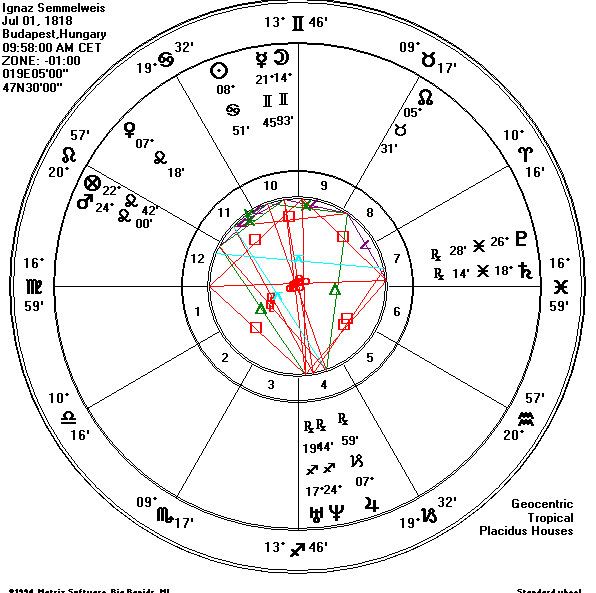
Any contact between Sun and Jupiter represents, among many other things, predilection or urge to save (Jupiter) life/lives (Sun). Since his Sun is in the motherly sign of Cancer, he intended to save the lives of mothers, hence his nickname “saviour of mothers”. But, since his Sun is in opposition with Jupiter, which is, furthermore, in the sign of its fall, his theory (Jupiter) how that can be done was met with, logically, opposition from his peers and was rejected on the ground that he didn’t have a proof (Capricorn, Saturn) for his claim. As it turned out, his ambition or intent to save the lives of mothers costed him his reputation, sanity and, eventually, his life (Sun). Perfect example how a challenging aspect between two affirmative planets can bring benefit to others but work against the interest of the individual in question.
Sun in connection with Jupiter and Saturn form one of three major configurations in his chart. While this one describes who he was, what was his profession and what he is known or famous for, the second configuration, which is most complex, describe all those little details and nuances of what he essentially noticed and discovered in 1847. It consists of six planets, Mercury in conjunction with Moon in Gemini, both planets in opposition to Uranus and Neptune in Sagittarius and all for planets in square to Saturn and Pluto in Pisces.
In order to understand how Semmelweis came to his discovery and how this complex configuration precisely shows it, it is first necessary to understand what exactly happened in 1847.
Semmelweis was appointed assistant to Professor Johann Klein in the First Obstetrical Clinic of the Vienna General Hospital on 1 July 1846. Two maternity clinics were at the Viennese hospital. The First Clinic had an average maternal mortality rate of about 10% due to puerperal fever. The Second Clinic’s rate was considerably lower, averaging less than 4%. This fact was known outside the hospital. The two clinics admitted on alternate days, but women begged to be admitted to the Second Clinic, due to the bad reputation of the First Clinic. Semmelweis described desperate women begging on their knees not to be admitted to the First Clinic. Some women even preferred to give birth in the streets, pretending to have given sudden birth en route to the hospital (a practice known as street births), which meant they would still qualify for the child care benefits without having been admitted to the clinic. Semmelweis was puzzled that puerperal fever was rare among women giving street births. “To me, it appeared logical that patients who experienced street births would become ill at least as frequently as those who delivered in the clinic. What protected those who delivered outside the clinic from these destructive unknown endemic influences?”
Semmelweis was severely troubled that his First Clinic had a much higher mortality rate due to puerperal fever than the Second Clinic. The two clinics used almost the same techniques, and Semmelweis started eliminating all possible differences, including even religious practices. The only major difference was the individuals who worked there. The First Clinic was the teaching service for medical students, while the Second Clinic had been selected in 1841 for the instruction of midwives only.
What is so amazing about Astrology is that natal chart doesn’t only show personality traits, inclinations and attributes, but also ambiences and circumstances that the person in question is going to find themselves in, without them consciously willing or wanting it. How and why that happens is hard to explain without using the unpopular word destiny.
How this fact played out in this particular case is uncanny. As a remainder, in the chart of Ignaz Semmelweis Mercury and Moon are in the sign of Gemini in opposition to Uranus and Neptune in Sagittarius and square to Saturn and Pluto in Pisces.
So, he was appointed assistant in a hospital (Neptune) that had two (Mercury, Gemini) maternity (Moon) clinics. The First Clinic was the teaching (Mercury) service for medical (Neptune) students (Mercury), while the Second Clinic had been selected for the instruction (Mercury) of midwives (Moon) only.

Furthermore, Semmelweis described desperate (Saturn) women (Moon) begging (Saturn) on their knees (Saturn) not to be admitted to the First Clinic, due to its high mortality (Pluto) rate. Some women even preferred to give birth (Moon) in the streets (Mercury), pretending (Neptune) to have given sudden (Uranus) birth (Moon) en route (Mercury) to the hospital (Neptune).
All of these external circumstances have nothing to do with Semmelweis, he didn’t cause them, he simply found himself in that situation, but for some strange reason, all of them can be delineated from HIS chart.
Semmelweis’ breakthrough occurred in 1847, following the death of his good friend Jacob Kolletschka, who had been accidentally poked with a student’s scalpel while performing a post mortem examination. Kolletschka’s autopsy showed a pathology similar to that of the women who were dying from puerperal fever. Semmelweis immediately proposed a connection between cadaveric contamination and puerperal fever.
He proposed that he and the medical students carried “cadaverous particles” on their hands from the autopsy room to the patients they examined in the First Obstetrical Clinic. This explained why the student midwives in the Second Clinic, who were not engaged in autopsies and had no contact with corpses, saw a much lower mortality rate.
The germ theory of disease had not yet been accepted in Vienna. Thus, Semmelweis concluded some unknown “cadaverous material” caused childbed fever. He instituted a policy of using a solution of chlorinated lime for washing hands between autopsy work and the examination of patients. He did this because he found that this chlorinated solution worked best to remove the putrid smell of infected autopsy tissue, and thus perhaps destroyed the causal “poisonous” or contaminating “cadaveric” agent hypothetically being transmitted by this material.
These paragraphs show clearly the influence of Saturn and especially Pluto in Pisces in squares with Mercury, Moon, Uranus and Neptune.
His breakthrough (Uranus) occurred following the death (Pluto) of his friend (Uranus) who had been accidentally (Uranus) poked with the scalpel while performing postmortem (Pluto) examination (Mercury). After his friend’s autopsy (Pluto) Semmelweis immediately proposed a connection (Mercury) between cadaveric (Pluto) contamination (Neptune) and puerperal fever. He proposed that he and the medical students carried “cadaverous (Pluto) particles” on their hands (Mercury) from the autopsy (Pluto) room to the patients they examined in the First Obstetrical Clinic. After that, he instituted a policy of using a solution of chlorinated lime for washing (Moon) hands (Mercury) between autopsy (Pluto) work and the examination (Mercury) of patients (Neptune). He did this because he found that this chlorinated solution worked best to remove (Saturn) the putrid smell (Saturn) of infected (Neptune) autopsy (Pluto) tissue, and thus perhaps destroyed (Pluto) the causal poisonous or contaminating (Neptune) cadaveric (Pluto) agent hypothetically being transmitted (Mercury) by this material.

So, all these events activated this complex configuration in his chart to the fullest. What is most important is that the most significant part of this configuration is Mercury, which is the only planet in his chart that is in domicile, which makes this planet the final dispositor of the chart. Since Mercury is the ruler of the ASC and, therefore, represent Semmelweis most directly, we can see what was the purpose and aftermath of all these events.
The purpose of these events was to make him perplexed, curious and to wonder (Mercury) what is happening and to care (Moon) enough to figure out and understand (Mercury) what can be done about it, what is the cause and solution to the problem. It is only logical that someone with the ASC in Virgo come to the conclusion that the problem is in hygiene and cleanliness (Virgo) and since Mercury is in Gemini, it is the cleanliness of hands (Mercury, Gemini) or lack (Saturn) thereof that is the problem. Since midwifes (Moon) hands (Mercury) were still contaminated (Neptune) with “cadaveric” (Pluto) particles after being washed (Moon) with only soap, they should be washed in a more special, unorthodox (Uranus) way, with chlorinated solution. Only then are those particles removed (Saturn) and, thus, the transmission (Mercury) of disease (Neptune) is prevented (Saturn).
The result was the mortality rate in the First Clinic declined 90% and was then comparable to that in the Second Clinic. The mortality rate in April 1847 was 18.3%. After hand washing was instituted in mid-May, the rates in June were 2.2%, July 1.2%, August 1.9%, and, for the first time since the introduction of anatomical orientation, the death rate was zero in two months in the year following this discovery.
This paragraph shows when hand washing was carried out and what results it produced. If we look at the transits for that period, what is noticeable is that in mid-May, Jupiter transited through Gemini, through Semmelweis’s 10th house and across his natal Mercury, while in July it transited over his Sun. So, it is not surprising that he came to that discovery in precisely that period.
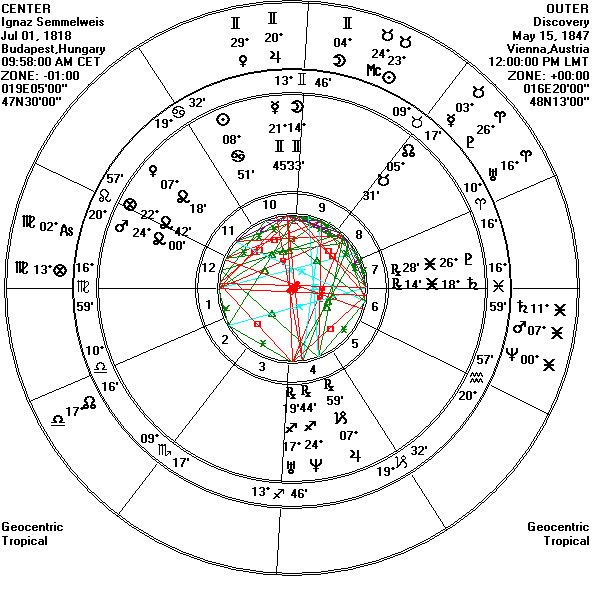
One planet not mentioned so far is an important part of the third major configuration in Semmelweis’s chart. That planet is Mars, which, placed at the 24° of Leo in the 12th house as the ruler of the 8th house, is the only planet in his chart that forms mainly harmonious aspects towards other planets, most notably, sextiles with Mercury and Moon in Gemini and trines towards Uranus and Neptune in Sagittarius. This placement of Mars and its aspects shows, on the one hand, the validity of the rectification of his chart, while on the other hand it provides an important insight into what the harmonious aspects of a malefic planet placed in a malefic house actually represent and how they should be understood and analyzed.
Mars placed in the 12th house as the ruler of the 8th house (death) in Aries clearly shows how and where Semmelweis died. After suffering a nervous breakdown in 1865, he was committed to an asylum (12th house) by his colleagues. While in there he was beaten (Mars) by the guards. 14 days later, on August the 13th, he died from a gangrenous wound (Mars), due to an infection (Neptune) on his right hand (Mercury) which might have been caused by the struggle (Mars).
This is one of the best examples what often happens when a malefic planet placed in a malefic house forms harmonious aspects with other planets. It is not an indication that something good might happen, but that bad things will happen in swift, undisturbed manner and without much inhibitions and obstacles.
Mars in the 12th house as ruler of the 8th house shows how and where Semmelweis died, but does not show when he died. The reason his untimely death occurred in 1845 at the age of just 47 is shown by the progressions and transits of the planets for that period.
In the first place, precisely in 1845, the progressed Sun (life) was at the 23° 54’ of Leo, just six minutes behind natal Mars, the ruler of the 8th house (death). Also, secondary progressed Mercury and Mars (rulers of the 1st and 8th house) were in conjunction in the sign of Virgo in his natal 1st house during that year.
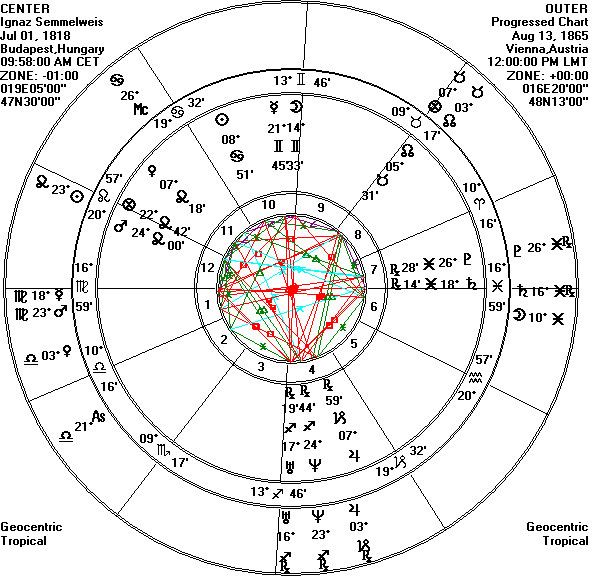
The occurrence of secondary progressed Mercury on 18° of Virgo in conjunction with secondary progressed Mars on 23° of the same sign is, taken in isolation, not so significant since they are neither in exact conjunction nor is 1865 the only year in which they progressed through his 1st house. The reason this position of these two planets is so important is because, on 13th of August 1865 transiting Mercury and Mars formed a conjunction in Virgo.
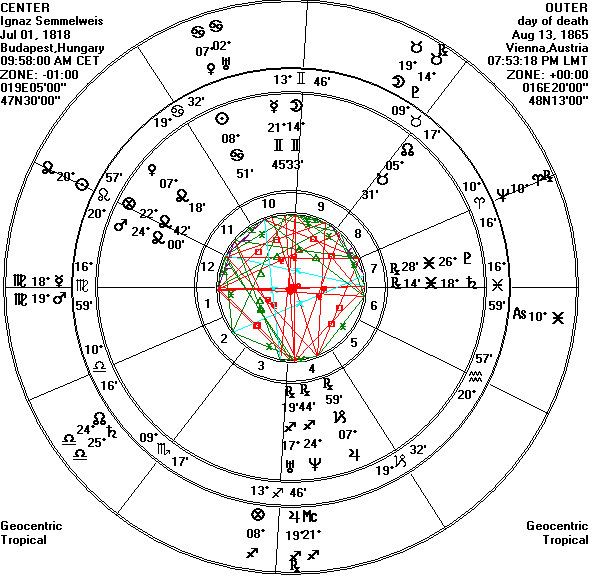
Transit Mercury was on that day on 18° of Virgo in exact conjunction with secondary progressed Mercury, while transiting Mars was on 19° of Virgo. Transiting Mercury and Mars activated secondarily progressed Mercury and Mars into action. Even more interesting is that secondary progressed Mars on 23° of Virgo is in exact square with secondary progressed Neptune on 23° of Sagittarius.
As a remainder, in his natal chart Mars is in Leo in trine with Neptune and sextile with Mercury and combination of these three planets precisely describe infection (Neptune) of wound (Mars) on the hand (Mercury) which caused his death.
His Solar return chart for 1865 is also very revealing. What immediately catches the eye is the position of Mars at 22° of Leo, which is the same position as it is in the natal chart, only two degrees behind.
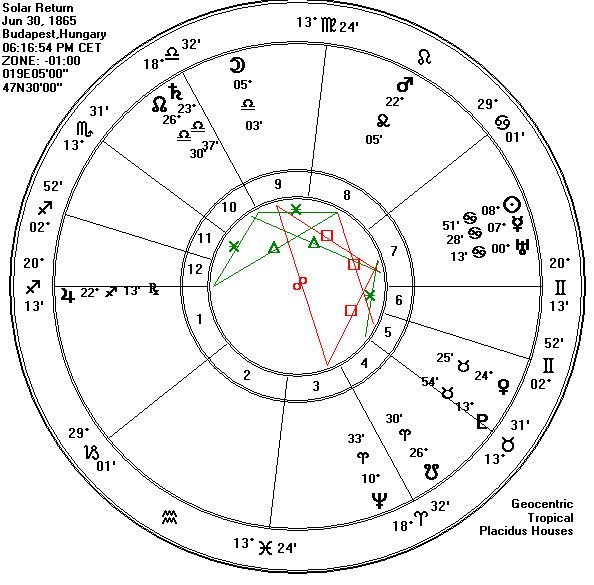
More importantly, in Solar return chart Mars in Leo is located in the 8th house (death) and is in trine with Jupiter in Sagittarius which is the ruler of the 1th house, while in the natal chart, Mars in Leo is in sextile with Mercury which is the ruler of the 1th house.
The reason why the horoscope of Ignaz Semmelweis is so disastrous and why, consequently, his life was so turbulent and why it ended so tragically is not because it is filled with various challenging aspects but because these afflictions actually lead from one to another.
For example, it is a fact that his chart contains an opposition between the Sun and Jupiter. Yes, this is, by definition, a challenging aspect, but these two planets are affirmative and positive in nature. Therefore, this opposition does not always have to bring only negative tendencies and events, especially if the dispositors of these planets are well placed and in good aspects. The problem is that the dispositors of these two planets, the Moon and Saturn, are in a square. This circumstance brings new challenges, frictions and conflicts (square), but the influence of this square can be mitigated and lead to a positive outcome if the dispositors of the Moon and Saturn are well placed and in good aspects. The problem is that the dispositors of these two planets, Mercury and Neptune, are in opposition and since Mercury is the final dispositor of the chart, everything ends with its position and aspects that this planet forms, which are, unfortunately, mainly challenging aspects (oppositions towards Uranus and Neptune and squares with Saturn and Pluto), but also, some constructive aspects, like conjunction with the Moon and sextile with Mars. Ironically, combination of Mercury, Moon and Mars precisely describe someone who understood (Mercury) and found the solution for childbed (Moon) fever (Mars).
So basically, one opposition leads to a square that leads to another opposition. For this reason, his accurate assessment of the cause of puerperal fever and the solution he came up with how to prevent it were met with denial, rejection and ridicule by the scientific community and up to almost 20 years of futile struggle and misery.

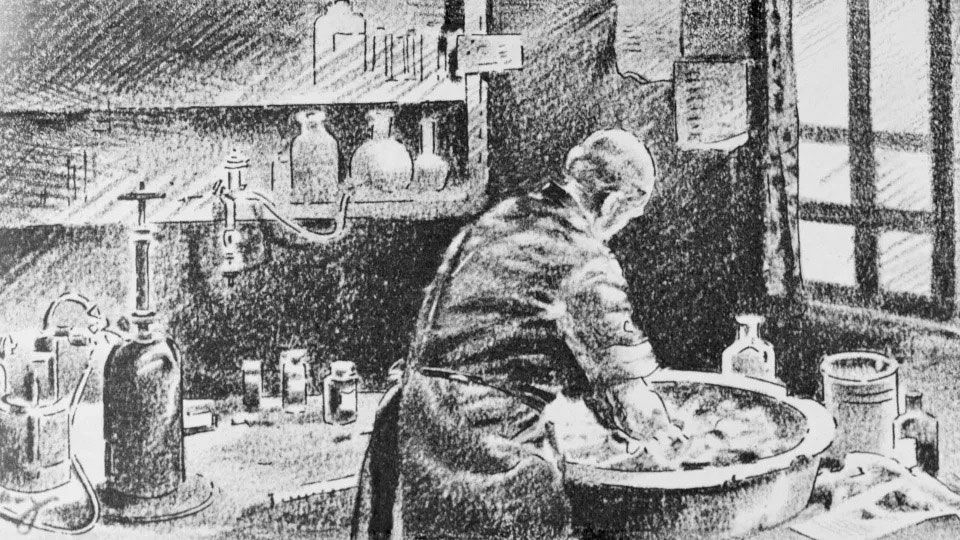



Pingback: Nedeljni horoskop od 19.2 do 26.2.2024 - AstroRegulus
Pingback: Ljubavni horoskop od 21.2 do 28.2.2025